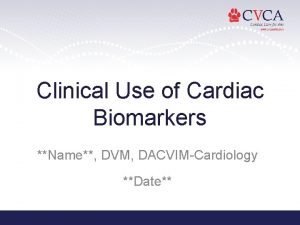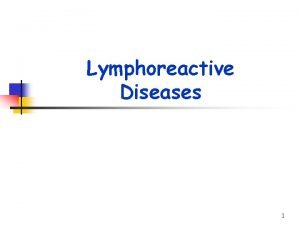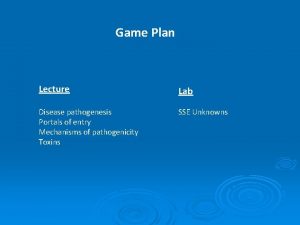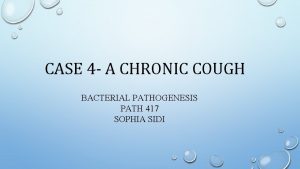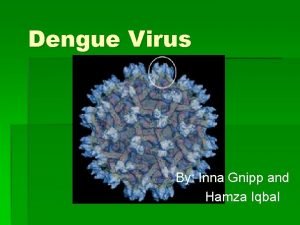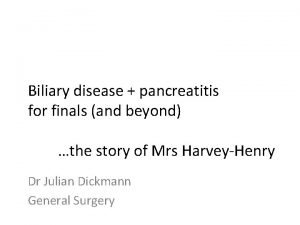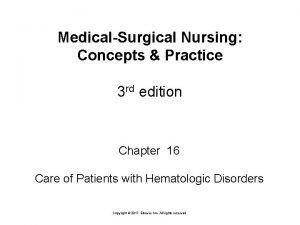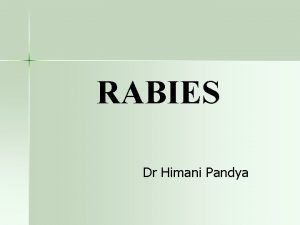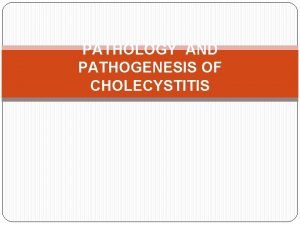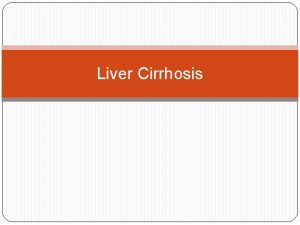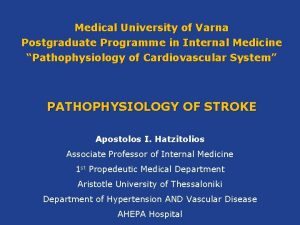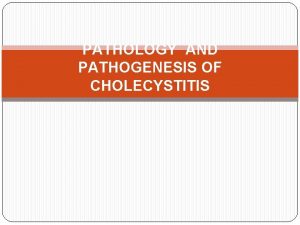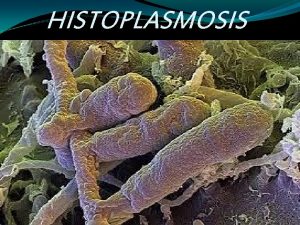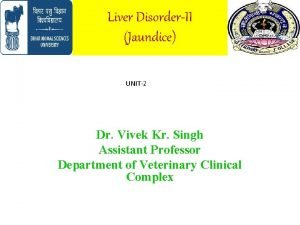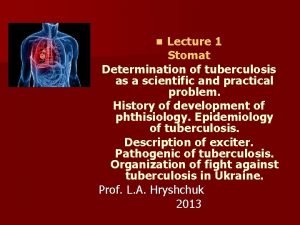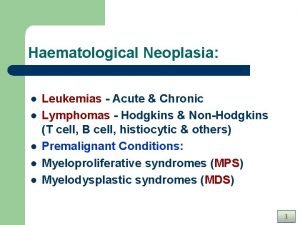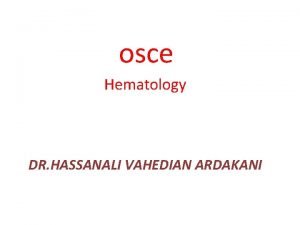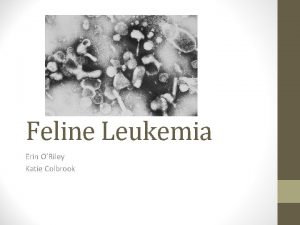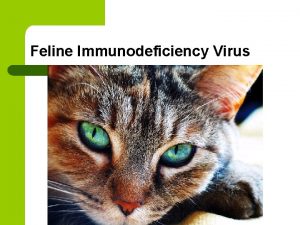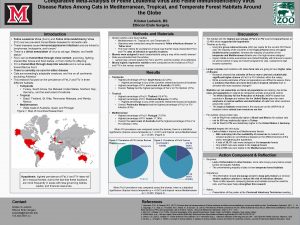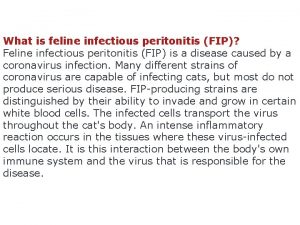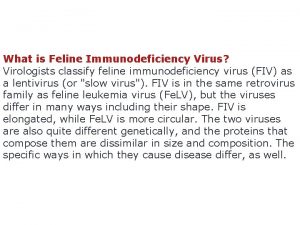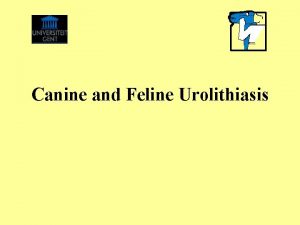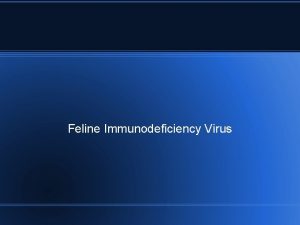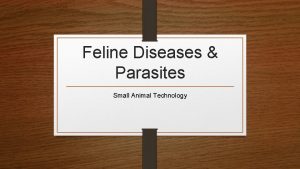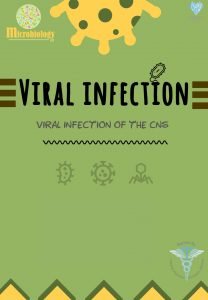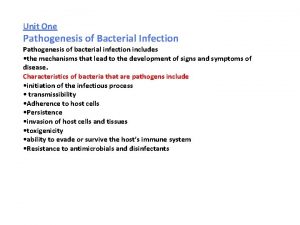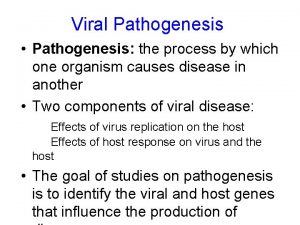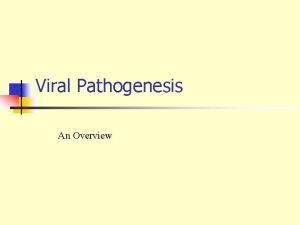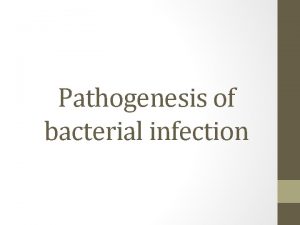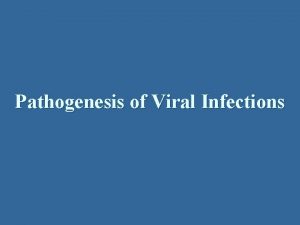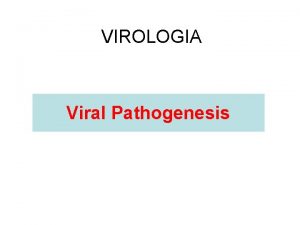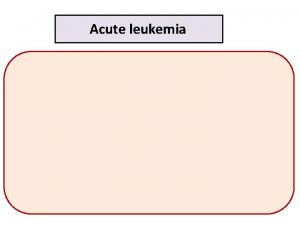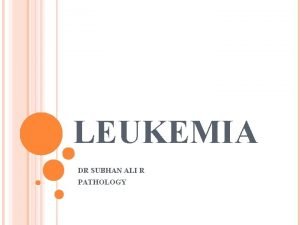Pathogenesis Prevention of Feline major diseases Feline Leukemia





















![Anigen Rapid FIV Ab/Fe. LV Ag Test Kit Sample collection & Storage [Whole blood] Anigen Rapid FIV Ab/Fe. LV Ag Test Kit Sample collection & Storage [Whole blood]](https://slidetodoc.com/presentation_image_h2/5ccf8bd1c5108d4f0177ad11746c9a16/image-22.jpg)










- Slides: 32

Pathogenesis & Prevention of Feline major diseases

Feline Leukemia Virus

Fe. LV - Introduction I. Retroviral infection II. Household clusters of lymphoma and lymphocytic leukemia led to the discovery of feline leukemia virus (Fe. LV) more than 40 years ago III. It appeared to be spread both vertically (from queen to kitten) and horizontally (from cat to cat) IV. That infection was associated with a variety of illnesses I. Neoplasia II. Bone marrow suppression III. Immunodeficiency

Fe. LV - Epidemiology Fe. LV is still among the most common infectious diseases of cats NUMBER TESTED I. In a study of more than 18, 000 North American cats tested in 2004, 2. 3% were positive for Fe. LV II. Certain diseases are associated with a high prevalence of Fe. LV infection I. Such as cutaneous abscesses II. Bite wounds (8. 8%) III. Oral inflammation (7. 3%) PREVALENCE Testing Site Animal shelter Veterinary clinic Source 8068 9970 1. 5% 2. 9% Clinic—indoors only 3613 1. 5% 2809 1. 5% 4550 709 1. 6% 1. 7% 6357 3. 6% 9556 8482 1. 4% 3. 3% Sexually intact female 2611 1. 7% Spayed female 6588 1. 9% Sexually intact male 5855 2. 5% Castrated male Health Status Healthy Sick 2984 2. 9% 15, 312 2726 1. 6% 6. 3% Shelter—relinquished pet Shelter—stray Shelter—feral Clinic—outdoors access Age Juvenile Adult Sex

Fe. LV – Pathogenesis I. General - Horizontal transmission of Fe. LV most commonly via the oronasal route and by bite wounds II. Mucosal or cutaneous inoculation of Fe. LV I. Replicates in local lymphoid tissues Carry the virus to other target tissues I. Thymus, spleen, and lymph nodes. II. At this stage of acute viral replication, fever, malaise, diarrhea, and leukopenia are common. III. In addition, generalized lymphadenopathy may be so marked as to be mistaken for lymphoma. III. It has long been believed that susceptibility to Fe. LV is much higher for kittens than for adult cats More recent studies, however, have demonstrated efficient natural and experimental infection of adult cats as well

Fe. LV – Pathogenesis I. Bone Marrow Disorders I. The most common clinical syndrome associated with Fe. LV infection Fe. LVinduced anemia II. Fe. LV is the most common cause of thrombocytopenia and granulocytopenia. Fe. LV and myeloproliferative diseases accounted for 44% of cats with thrombocytopenia in one report II. Neoplasia I. Fe. LV-infected cats have sixty-fold increased risk of developing lymphoma compared with Fe. LV-negative cats II. Multicentric and mediastinal lymphoma are the most common forms to occur in Fe. LV-positive cats III. Secondary Infections I. The most common secondary infections associated with Fe. LV are respiratory viruses that persist longer and cause greater illness than observed in immune competent cats

Fe. LV – Clinical signs Study 1 (3712 Fe. LV-infected cats ) Study 2 (8756 Fe. LV-infected cats ) Free of clinical signs (29%) Anemia 18% Weight loss (63%) Upper respiratory infections (11%) Fever (42%) Lymphoma (10%) Dehydration (35%) Myeloproliferative diseases (6%) Rhinitis (18%) Stomatitis (5%) Diarrhea (17%) Leukopenia (3%) Conjunctivitis (17%) Hemoplasmosis (3%) Oral inflammation (15%) Lymphadenopathy (3%) Lymphadenopathy (13%) Uveitis (2%). Abscesses (12%)

Fe. LV – Diagnosis I. Accurate diagnosis of retroviral infections is important for both uninfected and infected cats I. Identification and segregation of infected cats is considered to be the most effective method for preventing new infections II. The American Association of Feline Practitioners I. recommends testing for retrovirus infection when cats are newly acquired, sick, about to be vaccinated against Fe. LV or FIV III. Confirmation of a positive screening test result Antigen test IV. Immunofluorescent antibody (IFA) test on blood smears or bone marrow V. PCR - highly sensitive test for Fe. LV DNA I. But is also highly susceptible to technical errors and poor quality control that can reduce the accuracy of results

Fe. LV – Diagnosis I. Well-timed test procedure for Ag detection I. Samples should be collected prior to Fe. LV vaccine administration. II. Since Fe. LV tests are based on detection of antigen or DNA and not antibodies, vaccination against Fe. LV does not generally interfere with testing. III. However, blood collected immediately following vaccination may contain detectable Fe. LV antigens or DNA circulating from the vaccine. IV. The duration of vaccine interference with testing is unknown. should be test before vaccination.

Feline Immunodeficiency virus

FIV – Introduction I. AIDS in domestic cats I. Feline immunodeficiency virus (FIV) is a lymphotropic lentivirus II. Like HIV in humans, causes an acquired immunodeficiency syndrome (AIDS) III. Both viruses also share a similar pattern of pathogenesis characterized by a long period of clinical latency during which immune function gradually deteriorates II. FIV has a worldwide distribution in domestic cat Infection rates approaching one third of the cats in some populations III. Field strains of FIV are divided into 5 subgroups, or clades (A-E), based on sequence differences in the envelope gene

FIV – Epidemiology NUMBER TESTED Prevalence of FIV in a recent survey of 18, 038 cats tested at veterinary clinics and animal shelters in North America 2. 5% of cats overall with higher risk among cats tested at veterinary clinics than cats tested at animal shelters Despite the availability of point-of-care testing for FIV infection, fewer than one quarter of all cats in the United States have ever been tested PREVALENCE Testing Site Animal shelter Veterinary clinic Source 8068 9970 1. 7% 3. 1% Clinic—indoors only 3613 0. 9% 2809 1. 4% 4550 709 1. 6% 3. 9% 6357 4. 3% 9556 8482 1. 0% 4. 1% 6588 1. 2% 2611 1. 7% Sexually intact male 5855 3. 3% Castrated male Health Status Healthy Sick 2984 4. 3% 15, 312 2726 1. 8% 6. 1% Shelter— relinquished pet Shelter—stray Shelter—feral Clinic—outdoors access Age Juvenile Adult Sex Spayed female Sexually intact female Prevalence of FIV Infection in 18, 038 Cats Tested in Veterin ary Clinics and Animal Shelters in North America

FIV – Epidemiology I. Transmission - horizontal transmission among adult cats I. Most cases of FIV infection II. Worldwide, adult male cats living outdoors - consistently compose the majority of FIV-infected cats and the risk is highest for sexually intact males III. Infectious virus is found in the saliva of FIV-positive cats The fighting and biting behavior of this group of cats is believed to be the main source of transmission **Interestingly, sexual transmission, the most common mode of transmission of HIV, appears to be unusual in FIV, even though the semen of infected cats frequently contains infectious virus.

FIV – Pathogenesis I. Mild clinical signs - transient fever, lymphadenopathy, and leukopenia High concentrations of virus in the blood can be detected by culture and PCR within 2 weeks of infection II. Immune response I. Inversion of the CD 4+: CD 8+ T lymphocyte ratio (CD 4<CD 8) persists for the rest of the cat's life II. Infected lymphocytes and macrophages carry the virus to other organs III. Decrease in cell-mediated immunity Changes in cytokines, decreased natural killer cell activity, mitogen responsiveness, memory cell activity, and neutrophil function IV. Increased B cell activity and nonspecific immunoglobulin production polyclonal gammopathy

FIV – Clinical signs I. Asymptomatic stage I. FIV-infected cats enter a prolonged asymptomatic stage Progressive dysfunction of the immune system occurs II. Chronic inflammatory conditions, neoplasia, and infections with intracellular organisms are common III. FIV-infected cats also appear to respond adequately to vaccination Cell-mediated immunity is more profoundly affected than humoral immunity IV. Most cats experience a prolonged asymptomatic period following FIV infection In a study of 2079 FIV-infected cats, 88% were free of clinical signs **The true percentage of asymptomatic cats is likely to be higher than this because cats in this study were selected only from those sick or at high risk

FIV – Clinical signs I. Clinical Signs I. Weight loss (51%), fever (36%), oral infections (27%), dehydration (21%), rhinitis (19%), conjunctivitis (19%), and abscesses (16%). - nonspecific II. Stomatitis I. The most common condition diagnosed in 826 FIV-positive cats evaluated at veterinary teaching hospitals and included 18% of the cats III. Others I. Renal disease (11%), anemia and leukopenia (11%), upper respiratory infections (9%), neoplasia (7%), and ocular inflammation (6%). II. Survival Rate I. Median survival of 1011 FIV-infected cats was 4. 9 years from the time of diagnosis compared to 6. 0 years for 8639 age- and sex-matched uninfected control cats

FIV – Diagnosis I. Less than 25% of cats are ever tested even in USA II. Detection of antibodies - for routine diagnostic screening I. FIV produces a persistent, lifelong infection II. Detection of antibodies in peripheral blood of unvaccinated cats. III. Most cats produce antibodies to FIV within 60 days of exposure **Development of detectable antibodies may be considerably delayed in some cats IV. false-negative I. Cats with end-stage infection revert to a seronegative status II. If the results of antibody testing are negative but recent infection cannot be ruled out should be repeated a minimum of 60 days after the last potential exposure

FIV – Diagnosis I. Vaccination – has complicated the diagnosis of FIV infections. I. Antibodies were detected by currently available ELISA kits as early as 2 weeks after administration of the first vaccine dose and persisted for at least 1 year. II. Some cats have been reported to have positive FIV antibody tests for more than 4 years after their last FIV vaccination. III. Colostral FIV antibodies I. Kittens born to FIV-vaccinated queens absorbed colostral FIV antibodies that were detected at 2 days of age. A majority of kittens still tested positive for FIV at 8 weeks of age, but all were negative by 12 weeks of age. II. Thus, FIV vaccination of queens results in passively acquired FIV antibodies in kittens that frequently persist past the age of weaning, when many kittens are tested for FIV prior to adoption as new pets. **There are no routinely available diagnostic tests that can differentiate FIV-infected cats from vaccinated cats.

FIV – Diagnosis I. Failure of PCR tests I. FIV is unique in that various strains have high genetic diversity that contributes to failure of PCR tests to detect all isolates II. The accuracy of PCR is also affected by quality control issues A comparison of performance of FIV PCR tests offered by different laboratories has shown widely variable results III. In one study, test sensitivities (the ability to detect infected cats) ranged from 41% to 93%, and test specificities (the ability to exclude uninfected cats) ranged from 81% to 100% IV. Real-time PCR test has become available that is 80% sensitive and 99. 9% specific when used as a confirmatory assay following a positive FIV antibody test

FIV – Diagnosis I. Positive FIV antibody tests in kittens are unreliable I. Antibodies from FIV-infected or FIV-vaccinated queens are passed to kittens in colostrum these antibodies often persist past the age when many kittens are adopted into new homes and first tested for retroviral infection II. Most kittens that test positive for FIV antibodies are not truly infected and will eventually revert to a seronegative status III. It is recommended that kittens with positive FIV antibody tests be segregated from other cats and then undergo retesting every 1 to 2 months IV. Kittens that remain seropositive at 6 months are considered to be infected

Anigen Rapid FIV Ab/Fe. LV Ag Test Kit Special features -Chromatographic immunoassay for the qualitative detection of Feline Leukemia virus antigen and Feline Immunodeficiency virus antibody in feline serum, plasma or whole blood. -The specially selected Feline Immunodeficiency virus antigen and Feline Leukemia virus antibody are used in the test band as both capture and detector materials. -Identify Feline Leukemia virus antigen and Feline Immunodeficiency virus antibody in feline serum, plasma or whole blood with a high degree of accuracy.
![Anigen Rapid FIV AbFe LV Ag Test Kit Sample collection Storage Whole blood Anigen Rapid FIV Ab/Fe. LV Ag Test Kit Sample collection & Storage [Whole blood]](https://slidetodoc.com/presentation_image_h2/5ccf8bd1c5108d4f0177ad11746c9a16/image-22.jpg)
Anigen Rapid FIV Ab/Fe. LV Ag Test Kit Sample collection & Storage [Whole blood] - Collect on anticoagulated blood sample in EDTA, heparin or citrate using standard clinical laboratory procedures. - Anticoagulated whole blood samples should be tested within 24 hours of drawing. -If delays are expected, samples should be stored either on ice or refrigerated(2~7℃), but should not be frozen. [Plasma] - Collect an anticoagulated blood sample using standard clinical laboratory procedures. -Separate plasma by centrifugation. [Serum] -Collect and prepare serum samples using standard clinical laboratory procedures. – ** Plasma/Serum samples may be stored refrigerated (2~7℃) for up to 72 hours; for longer storage, freeze at or below -20℃ in vials with air-tight seals.

Anigen Rapid FIV Ab/Fe. LV Ag Test Kit Procedure of the test 1) Remove the test device from the foil pouch, and place it on a flat and dry surface. 2) Using the disposable capillary tube , add one (1) drop (approximately 10 ul) of feline serum, plasma or whole blood into the sample hole, and then add two (2) drops (approximately 60 ul) of the assay diluents. 3) If the migration has not appeared after 1 minute, add one more drop of the assay diluents to the sample well. 4) Interpret test results at 10 minutes. Do not interpret after 10 minutes.

Anigen Rapid FIV Ab/Fe. LV Ag Test Kit Interpretation of the test Negative result - The presence of only one band within the result window on both of the FIV Ab and Fe. LV Ag test areas indicates a negative result. Simultaneous FIV Ab and Fe. LV Ag Positive result - The presence of two color bands (“T” and “C”) within the result window on both of the Fe. LV Ag and FIV Ab test areas respectively, indicates a positive result of Feline Leukemia virus Ag and Feline Immunodeficiency virus Ab simultaneously

Anigen Rapid FIV Ab/Fe. LV Ag Test Kit Interpretation of the test FIV Ab Positive result - The presence of two color bands (“T” and “C”) within the result window on the FIV Ab test area, and the presence of only one band (“C”) within the result window on the Fe. LV Ag test area, indicates a positive result of Feline Immunodeficiency virus Ab. Fe. LV Ag Positive result - The presence of two color bands (“T” and “C”) within the result window on the Fe. LV Ag test area, and the presence of only one band (“C”) within the result window on the FIV Ab test area , indicates a positive result of Feline Leukemia virus Ag.

Anigen Rapid FIV Ab/Fe. LV Ag Test Kit Interpretation of the test Invalid result - If the purple color band is not visible within the result window after performing the test, the result is considered invalid. The directions may not have been followed correctly or the test may have deteriorated. It is recommended that the specimen be re-tested.

Fe. LV/ FIV - Prevention Household cats I. They are transmitted by bite wounds (in FIV) and nursing, mutual grooming, and sharing of dishes and litterpans(in Fe. LV) Positive cats in multicat household should be isolated from uninfected cats. II. Adding additional cats to households with mixed infection status is discouraged Because disturbance of the existing social structure may result in increased aggressive interactions. III. Infected cats and cats with indeterminate status should be isolated indoors to protect other cats from infection and to reduce their risk of contracting other infectious diseases. IV. All blood donors should be confirmed free of infection.

Fe. LV/ FIV - Prevention The AAFP Recommendations for Management of Fe. LV and FIV in Cat Shelters Testing for Fe. LV and FIV Infection control Ideally, all cats in shelters will be tested for Fe. LV and FIV. Testing at admission is optional for singly housed cats Fe. LV vaccination is optional for singly housed cats. Testing is highly recommended for grouphoused cats. Fe. LV vaccination is highly recommended for all cats housed in groups and for both foster cats and permanent residents in foster homes. Testing, if not performed prior to adoption, should be recommended to the new owner before the cat is exposed to other cats. Cats should test negative for Fe. LV prior to vaccination. Testing should be repeated 60 days after the initial test and annually for cats kept in longterm group housing. Vaccination is not 100% effective against Fe. LV and should never be used in place of a test-and-segregate program. Testing one cat as a proxy for another or pooling samples from multiple cats for testing is inappropriate In contrast to the case for feline panleukopenia, herpesvirus, and calicivirus vaccines, the value of a single Fe. LV vaccine has not been determined. Therefore, Fe. LV vaccination is not recommended for feral cat TNR programs if program resources are needed for higher priorities. Each cat should be individually tested. FIV vaccination is not recommended for use in shelters Testing of both foster families' and adopters' own resident cats should occur prior to fostering or adopting a new cat. Strict adherence to universal precautions is required to prevent iatrogenic transmission of retroviruses in the shelter environment via contaminated equipment and secretions. Testing is optional in feral cat TNR programs Cats used for blood donation in shelters should be proved free of retroviral infection prior to donating blood. **Fe. LV, Feline leukemia virus; FIV, feline immunodeficiency virus; TNR, trap-neuter-return

Fe. LV/ FIV - Prevention Vaccination I. Cats should test negative immediately prior to vaccination Because there is no benefit to vaccinating cats that are already infected and because diagnostic testing after vaccination is difficult. II. Protection is not absolute So, vaccination should not be used as a substitute for testing to identify and isolate infected cats. III. The AAFP considers Fe. LV/ FIV vaccines to be noncore and recommends their use only in cats at risk of exposure However, vaccination of all kittens is highly recommended because the lifestyles of kittens are less foreseeable and frequently change after acquisition IV. Cat owners should understand that Fe. LV vaccines do not necessarily protect all cats against Fe. LV infection, and vaccination is not as effective as isolation.

Fe. LV/ FIV - Prevention Screening & Isolation I. The most important prevention method. Not vaccination. II. Cats should have negative test results for both Fe. LV and FIV prior to being introduced to group housing. III. A quarantine period of 60 days followed by retesting prior to introduction to the group is ideal. IV. Because tests are not 100% accurate, a cat could be admitted to the group with an undiagnosed infection annual retesting is advisable in shelters that house cats together long term

Fe. LV/ FIV - References

Thank You !!
 Primary prevention secondary prevention tertiary prevention
Primary prevention secondary prevention tertiary prevention Cardiopet probnp feline 1,500
Cardiopet probnp feline 1,500 Lymphoid
Lymphoid A famous author candy bar
A famous author candy bar Ecvo test
Ecvo test Candy bar story game
Candy bar story game Human with feline head
Human with feline head Feline
Feline Major nutritional deficiency diseases in emergencies
Major nutritional deficiency diseases in emergencies Pathogenesis game
Pathogenesis game Bacterial pathogenesis
Bacterial pathogenesis Nursing management of pyelonephritis
Nursing management of pyelonephritis Pathogenesis dengue fever
Pathogenesis dengue fever Renal disease
Renal disease Ibratropium
Ibratropium Bacterial pathogenesis
Bacterial pathogenesis Cholecystitis pathophysiology
Cholecystitis pathophysiology Pathophysiology of anemia
Pathophysiology of anemia Rabies pathogenesis
Rabies pathogenesis Pathogenesis of cholecystitis
Pathogenesis of cholecystitis Cirrhosis pathogenesis
Cirrhosis pathogenesis Nursing management of neonatal tetanus
Nursing management of neonatal tetanus Mechanism of ischemic stroke
Mechanism of ischemic stroke Appressorium diagram
Appressorium diagram Acute cholecystitis clinical features
Acute cholecystitis clinical features Histoplasma capsulatum pathogenesis
Histoplasma capsulatum pathogenesis Jaundice pathogenesis
Jaundice pathogenesis Pathogenesis of pleomorphic adenoma
Pathogenesis of pleomorphic adenoma Pathogenesis of tuberculosis
Pathogenesis of tuberculosis Chronic myeloid leukemia
Chronic myeloid leukemia Lll leukemia
Lll leukemia Leukémia wikipédia
Leukémia wikipédia Promyelocytic
Promyelocytic

